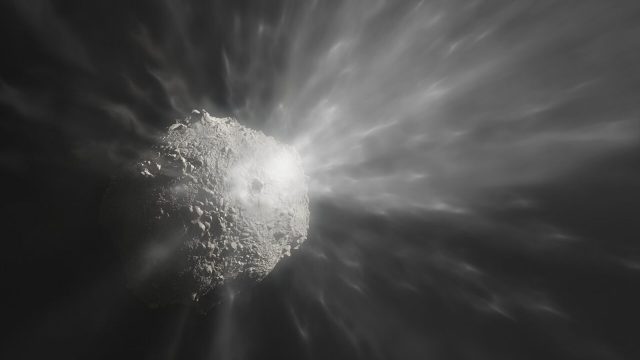The European Space Agency (ESA) has successfully launched Hera, its first planetary defence mission designed to assess whether future asteroids can be deflected from a collision course with Earth.
The probe, which is about the size of a small car, is on its way to a pair of asteroids 195 million kilometres away from Earth, one of which NASA deliberately crashed a spacecraft into two years ago.
It is ESA’s part of a collaboration with NASA to develop future technologies to protect the Earth from a catastrophic asteroid impact.
“The risk of an asteroid hitting our planet affects everyone everywhere, making planetary defence an inherently international endeavour,” said Josef Aschbacher, director general of ESA.
In September 2022, NASA’s DART mission deliberately crashed into the 151m-wide asteroid Dimorphos.
Its goal was to see if smashing a vending machine-sized space probe into an asteroid could nudge it enough to deflect it from a direct hit with Earth.
Read more on this:
Why NASA crashed a spacecraft into a harmless asteroid
Dimorphos is a moon of a larger asteroid, Didymos – the binary asteroid chosen as a target.
It was thought the smaller asteroid would remain in its parent’s gravitational pull, eliminating the risk of a future collision with Earth even if the prang with DART proved unpredictable.
Observations of the DART impact revealed it shifted Dimorphos’s orbit around Didymos by around 32 minutes – 26 times greater than the minimum deflection predicted by NASA scientists.
Hera is designed to provide a detailed post-match analysis of the DART-Dimorphos encounter so it can be developed into a strategy for planetary defence.
As well as studying Dimorphos and Didymos in detail using 11 on-board instruments, it will deploy two micro-satellites that will go into orbit around the asteroid system.
Their missions will end with the two probes landing on Dimorphos’s rubble-like surface, hopefully providing new details about its composition.
“Hera will gather the data we need to turn kinetic impact into a well understood and repeatable technique on which all of us may rely on one day,” said Mr Aschbacher.
While most of us think of civilisation-ending asteroid impacts as the stuff of Hollywood movies, they remain a genuine, albeit low, risk.
Over our 4.5 billion year history, Earth has suffered more than three million impacts from various bits of space rock.
Perhaps the most famous was the impact 66 million years ago of a 180km-wide asteroid in what is now Chicxulub, Mexico.
The resulting planetary-scale extinction event helped consign dinosaurs to the natural history books.
Things have now quietened down a bit, but just last week an asteroid missed Earth by about one million kilometres – less than three times the distance to the Moon – very close by astronomical standards.
Asteroid 2024 ON was 350m across, not a “planet-killer” but large enough to destroy an entire country and lead to catastrophic global climate impacts.
The concerning thing was that it was spotted less than two months ago – leaving little time to do anything to prevent an impact, if it was heading right for us.
That’s all the more reason for missions like Hera and DART to learn as much as possible about the nature of the asteroid threat, as well as how to defend against it.
Hera will swing by Mars in 2025 to help propel it towards its destination. It’s due to arrive at Didymos and Dimorphos in October 2026.





















